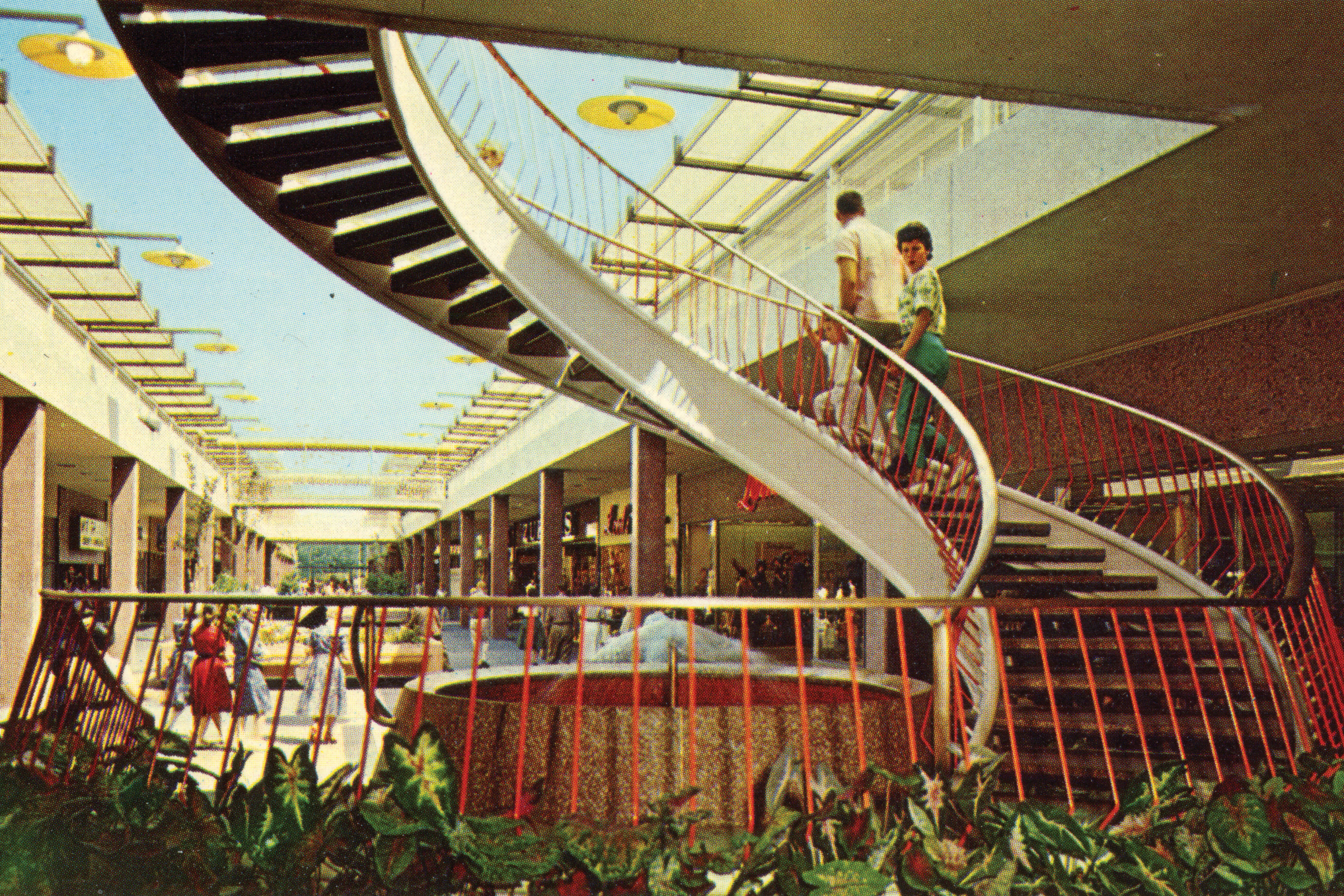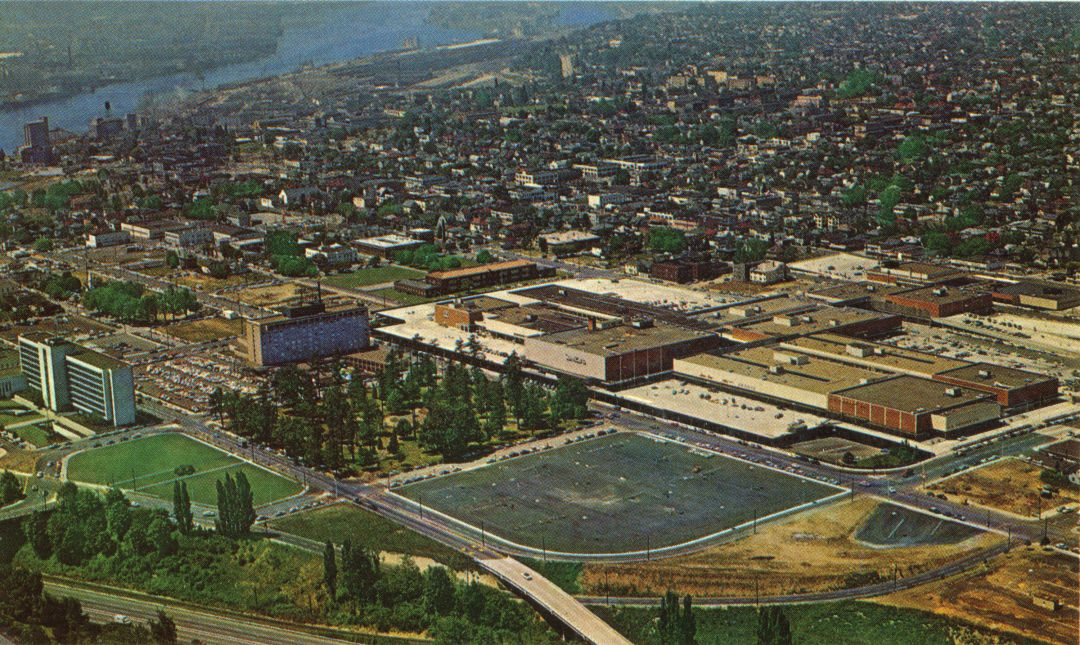
Can We Save the Lloyd Center?
It was raining on August 1, 1960, the day Lloyd Center officially opened to the public. But there was no dampening the gathered crowd’s electric mood. The next day, the Oregonian would wax religious, calling the drizzle a “fine sacramental-like mist,” baptizing the long-awaited, $100 million shopping center.
For 11-year-old Mary Botkin, whose family struggled to get by in their Northeast Portland home, the grand opening was the most exciting event of her life to that point.
“It was like San Francisco and Los Angeles come to Portland. It was monumental,” Botkin, now a retired labor advocate, says. “We anxiously waited for it to open. There were people handing out candy and cookies—a lot of things that usually cost money and we got them for free. I had three brothers. We were just hell on wheels.”
Since the mid-1950s, planners had been riding their own sugar high, bragging that the sprawling 40-acre center would be bigger than the Northgate Mall in Seattle—always a good thing. On completion, the two-story, open-air mall was one of the largest urban shopping centers in the United States, and the first to include a central ice-skating rink. Was any thought given to the homes demolished to make way for it? The news reports do not say.
Mayor Terry Schrunk cut the red ribbon and released 700 homing pigeons, bound for destinations across the Northwest, bringing news of the mall’s opening in the most dramatic possible way.
“This is a symbolic beginning,” Gov. Mark Hatfield told the crowd. “This represents the hopes and dreams of men who have lived in the past and also the young of today. The state of Oregon can now say we are progressive in growth, in natural resources, and in the field of business.”
Smash cut to 2021: The Lloyd Center is still very much here, but Schrunk’s pigeons have come home to roost.
Within the past year, many stores have closed, including Macy’s, the last of the mall’s four big “anchor” stores. Bold pre-pandemic plans for a new midsize concert venue, cinema, and 1,100-unit apartment complex across the street have been shelved or abandoned entirely. As of press time, at least half of the Lloyd Center’s retail stalls stand vacant, with Ross and H&M holding on as the last “big” retailers.
A January 2021 Oregonian story declared the “Lloyd Center on the brink,” and quoted a departing kiosk owner saying, “I feel like this mall is going down.” Facebook is not the place to go to gather facts, but the hundreds of comments on that article do seem to point to a consensus, echoed in nearly any conversation about the future of the close-in east side: that the 61-year-old mall’s time is limited and the end can’t come soon enough. “This mall has been crumbling for yeeeaaarrs idk why people are surprised when to rent out one of the spaces costs a fortune that big ‘businesses’ can’t even afford it!” reads one comment. “Turn it into something useful!!”
Conversations about the ways COVID or Amazon has asphyxiated local retail may not evoke surprise, but they still tend to carry anger and sadness. The Lloyd Center, by contrast, doesn’t benefit from the city’s collective empathy.
Maybe because the owners are in Texas. Maybe because its tenants include a preponderance of corporate chains—your Forever 21s, your Sunglass Huts. Maybe it’s the crime in the surrounding area. Maybe it’s because, unless you’re arriving by car, it’s difficult to figure out how to get inside at all. Dallas-based EB Arrow, which purchased the mall from another Dallas-based company in 2018, did not respond to our questions. The Portland-based team (which currently has no general manager) was only a little less shy, wounded by recent press. There would be no phone call; an email would have to do.
“In the 60 years that Lloyd Center has been part of the Portland community we have been a place for Portlanders to shop, eat and play,” wrote the Lloyd Center’s marketing director, Ann Grimmer. “We are committed to continue being that place for the Portland community moving forward.”
Grimmer’s words do reflect historical fact: the Lloyd Center hasn’t always been a shell. For more than half of its life, it was a beloved fixture for locals—not just for shopping, but for socializing and entertainment.

Image: Courtesy Anderson Sundry Co.
The Lloyd Center was always meant to be more than “just” a mall. It would have clothes and jewelry, yes, but also grocery stores, a bank, a shoe repair shop, and opticians. It was conceived as a living neighborhood, a direct competitor to downtown itself. Investors boasted that 600,000 people lived within a 20 minutes’ drive of the mall. Businesses on the west side were “jolted” when its construction began. A visiting architect, reviewing the plans, warned the city that the Lloyd Center’s easily accessible shops and restaurants could hollow out downtown and shift the city’s core east of the Willamette.
“This was considered war on downtown by Lloyd Center,” says Fred Leeson, a former president of Portland’s Architectural Heritage Center, adding that the Lloyd Center Meier & Frank location directly rivaled its downtown counterpart. “Lloyd Center was hugely popular at the start.”
In contrast to the mall’s spacious walkways and central gardens—where soft music beckoned shoppers strolling among landscaped greens, carved statues, and fountains—downtown was plagued by high crime, pollution, and a stubborn commitment to drinking and gambling. While the Lloyd Center had a picturesque bridge high above the ice rink, where teenagers could meet their crushes in secret, downtown was known as a “scattered bomb-site of parking lots,” according to a 1969 New York Times piece.
For young Mary Botkin, the only area of downtown she was allowed to explore was a small square of blocks, bounded by SW Yamhill, Alder, Fifth, and Broadway. Outside of that zone, danger lurked in the form of cardrooms, bars, and adult theaters. But inside of it, too, at Meier & Frank’s proud flagship store, for instance, it lurked in the form of social alienation.
“When you shopped downtown, you wore gloves and stockings. That was the rule my grandmother would tell me. It was a higher-end experience,” recalls Botkin, whose first high school job was selling purses at Lloyd’s Thom McAn shoe store. For all its outward sheen, Botkin felt more at home there. “Lloyd Center was for people who worked for a living. It was for the unwashed masses. I didn’t know what the unwashed masses were then, but I think we were one of them.”
“There were wonderful things happening at the Lloyd Center. All the time,” she adds. “They celebrated every holiday. I think they made up holidays to celebrate. They always had gala events at the ice rink.”
Those halcyon days could not last. During the mid to late 1980s, as the building began to show its age and large tenants like Woolworth’s packed up and left, management made two fateful decisions that would accelerate its decline, and eventually turn the city against it. A $200 million remodel, completed in 1991, was intended to bring the open-air shopping center in line with indoor malls nationwide. They added more spaces for retail tenants, increasing the number of retail stalls. But they also added a labyrinth of multilevel parking garages outside, severing access to the south side of the building with an imposing and dark concrete barrier. Worse still, they encased the whole thing under a roof.
“That broke the image of what Lloyd Center once was,” says Leeson. “Now suddenly, it was really a very different thing.”
The other decision would eventually prove to be just as consequential: as TriMet was mapping out what would become the MAX’s Blue Line in the 1980s, Lloyd Center pushed back on a planned MAX stop on NE Multnomah Street which would have deposited riders directly outside the doors of Meier and Frank. TriMet acquiesced, says Leeson, and built the stop one block south, across Holladay Park.
Since that 1991 breakpoint, Lloyd Center’s story more closely follows the trajectory of any other shopping mall: higher rents and name brands slowly elbowing out the old local mainstays. Eventually, the newcomers began to disappear, too. Meanwhile, the city has poured millions in public money into the district, rezoning the entire neighborhood for high-density buildings and adding a streetcar line. The Moda Center and Oregon Convention Center are there now, but the area has proved resistant to investment.
Botkin, now 73, still visits, still feels a strong pull of nostalgia, still wonders how high schoolers will be able to find jobs without places like the Lloyd Center, like she did. She goes to test the stitching on jeans before she buys them or get a box from Joe Brown’s Carmel Corn, one of the few original vendors still operating. One of her friends, she says, recently learned how to make caramel corn herself.
“She goes, ‘Oh, I know it’s still there. But it’s not going to be there for long and I don’t know where else to go for caramel corn,’” Botkin says.

Image: Courtesy Anderson Sundry Co.
In a March 3 letter to the Oregonian, Todd Minnis, EB Arrow’s CEO, broke his silence: “When Lloyd Center opened in 1960, it was the largest mall in America. Thirty years later, it transformed into an enclosed mall. Now, another three decades later, we remain committed to another necessary transformation of this community institution that opens a new chapter in the Lloyd Center legacy.”
Indeed, the Lloyd Center has rarely remained static. Whatever massive investment in concert halls and movie theaters the pandemic may have interrupted, the mall had been actively trying to reinvent itself for years. A $100 million-plus remodel in 2016 brought in a brighter and cleaner look, a new food court, and a redesigned ice rink. Many of the Lloyd Center’s spaces were given over to for-profit schools and medical offices. “From Ralph B. Lloyd’s first vision of Lloyd Center as a ‘mini city within a city,’ the plans for the Center have always included local brands and business including retail, medical and office,” writes Grimmer, citing the California oilman who originally backed the project.
For now, the Lloyd Center appears to be here to stay, though in what form is anyone’s guess. Ambitious ideas have circulated online: A massive affordable housing complex or homeless shelter. A public park. A Major League Baseball stadium. To Leeson, who has no knowledge of the owners’ plans but sees potential in the old building, these ideas miss the point.
“One of the things that baffles me ... I like old buildings, but retail has no sense of history whatsoever,” says Leeson, “Everything has to be new and better. I think people want to scorn the past too easily.”
Let’s humor him. Let’s imagine a pre-1992 version of the original shopping center, without the roof, the parking structures, and the prison-like facade. An outdoor neighborhood of shops, restaurants, and services, with smaller spaces. A haven for a hammered local retail industry. Ralph Lloyd’s mini-city born again.
There is precedent. Vancouver, British Columbia’s Oakridge Centre, an older mall not unlike Lloyd with subway access and a convenient location, reinvented itself as a walkable main street with a surrounding residential district. There’s also, crucially, momentum: interest in investment downtown is waning due to a combination of the recession, the pandemic, and the damaging national narrative of a city on fire.
Maybe it’s time for the Lloyd Center to wage war on downtown once more.




